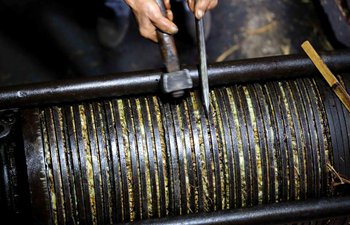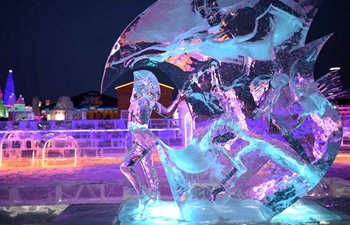by Xinhua writer Guo Ying
BEIJING, Jan. 19 (Xinhua) -- What did China's mythical beasts of 2,000 years ago look like? The recently published book "Mythic Beast" offers a glimpse.
Illustrated by Shi Lin, a Chinese artist born in 1989, the book contains more than 30 pictures of ancient mythical beasts, such as the nine-tail fox as well as a horse-like animal with one sharp horn on its head and a dog-like nine-headed animal.
Shi draws inspiration from the ancient Chinese classic "Shan Hai Jing" (Classic of Mountains and Seas), which dates back 2,200 years.
Shan Hai Jing gives both a cultural and geographical account of China before the Qin Dynasty. It contains geography, folklore, rich legends and fairy tales. It is a major source of Chinese mythology, including the tales of "Kuafu Chasing After the Sun" and "Nu Wa Patches up the Sky," which have been passed down from one generation to another in China.
Shi has been interested in reading ancient Chinese literature and drawing animals since a young age. When Shi was studying at the Academy of Fine Arts in Beijing, he received a collection of different versions of the Shan Hai Jing from his mentor and was fascinated by the book, especially the descriptions of mythical beasts.
"I appreciate the wisdom and romanticism of our ancestors through this book. Although the description of the mythical beasts is limited, I get a vivid picture in my mind from a word or two. I am eager to offer my adaptations of these unique creatures," Shi said.
Based on the classic, Shi combines his knowledge of animal anatomy and his imagination. He finished 16 pictures of the mythical beasts in 2012 as part of his graduation project.
After he shared the pictures online, they attracted wide attention. With the increasing popularity of fantasy-themed literature and games in China, some companies have hoped to cash in on his pictures, but he wants to maintain the integrity of his work.
To gain inspiration for his art, he visited zoos to observe every detail of real animals, including their joints, facial expressions and movements. However, he gradually realized the limitations of a strictly realistic painting style.
"Those caged animals lack movement and an animal spirit. How can they be compared with those unfettered and powerful mythical beasts?" Shi said.
A trip to Dunhuang in Gansu Province inspired Shi. He visited Mogao Grottoes, a shrine containing Buddhist art treasures in Dunhuang. He was deeply moved by the supernatural and spiritual scenes depicted in the frescoes and statues.
The visit also led him to think deeply about the Shan Hai Jing.
"As people in modern times are capable of conquering nature, humans represent the domination of nature," Shi said. "This mentality is quite different from the ancient people more than 2,000 years ago. For our ancestors living before the Qin dynasty, the world on the other side of the mountain is unknown, and people were in awe of nature and animals."
Shi retreated from city life and the Internet to create his art. He went to live in Yunnan Province to see the animals and plants in the wild, including the animal totems of the ethnic minorities.
Ma Changyi, an expert on Chinese mythology and Shan Hai Jing research, said that mythology is the spiritual force of national vitality and the cultural root of national spirit.
Shi hopes his book may offer a decoding of the classic that is suited to a modern audience, especially children, who tend to absorb information through pictures.
"Shan Hai Jing has more than 31,000 words and the myths are scattered throughout. Modern readers may feel at a loss if they read it for the first time," Shi said.
Shi has been happy to hear from some parents that their children appreciated the details in the pictures, such as swirling clouds.
To Shi's surprise, his book also attracted many of his foreign friends, indicating that traditional Chinese culture also has international appeal.
"Shan Hai Jing not only records the geography of China, it also records penguins in the Antarctic as well as many species in South America," said Shi. "The images of mermaids and unicorns in Western fantasy literature are similarly described in Shan Hai Jing. Images of human-faced birds and human-headed snakes may also be found in Western mythology."
Besides Shan Hai Jing, Shi is also fascinated with other ancient Chinese literary works and art forms. He hopes that in the future he may continue to find creative ways to depict traditional culture.
"China's traditional culture is a tremendous treasure and I hope more and more people can feel the charm of these treasures," Shi said.

















